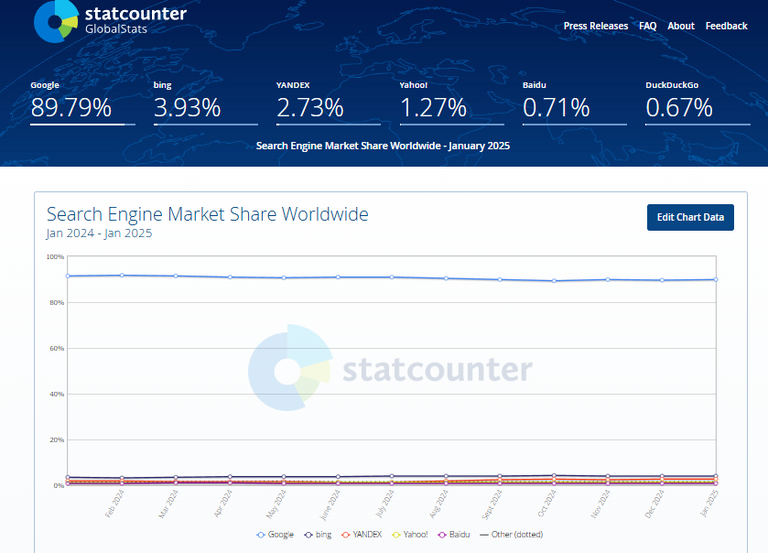
Although Bing (in our case the tool is called Bing Webmaster Tools) does not have the reach of Google (Google Search Console), it is not an SEO tool to be ignored considering that it simultaneously indexes Yandex, the popular Russian search engine.
As we can see in the graph prepared by StatCounter, GSC dominance is absolute, but Bing is slowly gaining ground.
For those interested in promoting their website in a medium other than Google, I recommend reading this fourth part of the guide for BWT.

Notification center
The notification center in Bing Webmaster Tools contains all alerts and messages that you get from Bing. You can access the notification panel from the top right corner of the header, by clicking on the bell icon, in your Bing Webmaster Tools account.
Tip: To keep yourself updated on issues related to your site/sites, we recommend setting up your email preferences to receive daily digests delivered to your inbox. It will ensure that you get daily notification of all New and Unread messages in your inbox, organized by site.
Filtering messages by site and issue types
If you are managing multiple sites within your account and receive messages for more than one site, you can filter your messages by site using the dropdown and selecting a site or issue type. You can also toggle for only Unread messages in the notifications panel.
Issue types
Different types of messages that Bing sends to webmasters via the notification panel or email:
Administrator: It includes messages sent to you by the administrator about changes in the services.
Crawl errors: These are automatically generated messages about errors we encounter while crawling a site that is part of your Webmaster Tools account.
Index issues: These are automatically generated messages about indexation issues on a site that is part of your Webmaster Tools account.
Malware: These are automatically generated alerts when we detect malware on a site that is part of your Webmaster Tools account.
Bing Ads: You will also get automatically generated messages about Bing Ads.
High-priority alerts for a site will also show up in your dashboard.
Deleting notifications
To delete a notification, hover over the card and click the corresponding Delete icon.
How to set email alert preferences
Selecting your email alert preferences is an important step in setting up your Bing Webmaster Tools account. It allows you to provide us permission to send email alerts and messages to your inbox, about new and unread messages in the Notifications Center of your Webmaster Tools account, keeping you updated all the time. You can select the alerts you would like to see in your inbox and the frequency of such email alerts.
Completing your profile
Just beside the notification icon in your Webmaster Tools account, you can set up your email preferences by clicking on the Settings icon (Gear icon).Bing Webmaster Tools Profile Update
IMAGE
Clicking on the Communication preference opens a drop down, where you can toggle in to receive communication, and set alert preferences for your business. This information is held securely. For more information, please check our Privacy Policy.
The Alert preference section allows you to select the items on which we should send alerts.
Crawl errors – we will send a message if we detect issues in crawling your site.
Index issues – we will send a message if there are issues that prevent us from indexing your site.
Account related – we will send a message if we come across errors/issues in your Bing Webmaster Tools account.
Promotional – we will alert you about any new features added to Bing Webmaster Tools, or about promotional offers for existing account or new accounts.
List of crawl error alerts
The table below describes the various crawl error alerts that we send to the Notifications Center when we see a significant or significantly increasing number of issues while crawling your site.
Issue category Specific type Alert Action message Comment
400-499
401 (Unauthorized)
We encountered a large number of requests that returned the following status: 401 (Unauthorized).
Your server is refusing access to your pages and requires additional information, such as a login and password. Check if you are unintentionally blocking your pages behind a login and password. If this is intentional, you could consider adding a disallow: rule to your robots.txt so that we no longer attempt to crawl your pages. When your server responds to our request with a status code of 401 (Unauthorized), it means we are trying to crawl an area of your site that is password protected and for which we would require additional authentication. Check some sample URLs for this error in the Crawl Information tool to see if this is expected or if you accidentally placed content in a password protected area. If this is expected, you can consider adding a disallow: directive to your robots.txt file so that we don't spend time (and bandwidth) crawling these protected URLs.
400-499
403 (Forbidden)
We encountered a large number of requests that returned the following status: 403 (Forbidden).
Your server is denying access to your pages to Bingbot. Check if you are unintentionally blocking some or all Bingbot requests on your server. Your server may have been configured to only accept Bingbot requests from specific IP ranges. Since Bingbot IP ranges may change over time, you may be accidentally blocking valid Bingbot requests. You need to check your server code to see if this is the case. To see whether Bingbot requests are coming from Bing machines instead of suspicious crawlers spoofing the Bingbot user agent, use the methods described in How to Verify Bingbot. Note that you can always use robots.txt directives to prevent Bingbot from crawling sections of your site. If you feel we are crawling your site too much, say during business hours, consider setting hourly crawl rates using the Crawl Control tool instead of blocking requests.
500-599
5xx (aggregate of all server errors).
We encountered an increase in the number of requests that resulted in a server error.
Your server reported a large number of server errors and was unable to fulfil our requests. This may be caused by a temporary issue, but it can also be a code error or a misconfiguration on the server. This alert is triggered if we notice a significant increase in overall server errors. The reason for these issues may vary, but you need to check your server logs to see if the issues are systemic.
500-599
500 (Internal Server Error).
We encountered a large number of requests that returned the following status: 500 (Internal Server Error)
Your server reported an internal server error and inability to fulfil our request. It can be a problem in your site's code or a misconfiguration.
This response code indicates that there was a problem in the server without more specifics. It implies a code issue or a configuration issue. You need to check a few URLs reporting this issue in the Crawl Information tool and check the server logs for additional clues.
500-599
503 (Service Unavailable).
We encountered a large number of requests that returned the following status: 503 (Service Unavailable).
Your server reported that it was unable to handle our requests. This could have been a temporary issue but check your logs and scripts for performance-related issues.
This response code is issued when the server is unavailable. Perhaps the server was overloaded or down for maintenance at that time. It could be a temporary problem, but you should check the samples in the Crawl Information tool (see the 500-599 section) to see if the problem persists.
500-599
509 (Bandwidth Exceeded).
We encountered a large number of requests that returned the following status: 509 (Bandwidth exceeded). Your server reported that bandwidth limit had exceeded, and that it was unable to handle our request. Please check your server configuration. When your server responds to requests with HTTP Status 509 (Bandwidth Exceeded), it could imply throughput issues or your server may be restricting the bandwidth that Bingbot is allowed to consume. Not addressing this issue can result in comprehensiveness and freshness issues. A recommended way to control the speed at which Bingbot crawls your site on an hour-by-hour basis is to use the Crawl Control feature in your Webmaster Tools.
Crawl politeness Crawl delay setting. Your crawl delay setting in robots.txt is preventing Bing from crawling effectively. Please remove the crawl delay setting in your robots.txt file. Make sure you have an optimal crawl rate setting configured on the Bing Webmaster Tools crawl control page. Bing honors the crawl-delay directive in your robots.txt file. If your crawl-delay directive prevents us from crawling your site efficiently you will receive this alert. Avoid using the crawl-delay directive and control Bingbot using the Crawl Control feature in Webmaster Tools.
Crawl politeness Increase crawl rate. The current crawl setting for your site is preventing Bing from crawling effectively. Please make sure you have increased the crawl rate setting configuration on the Bing Webmaster Tools crawl control page. This alert means that we would like to crawl your site more efficiently, but your current crawl control settings is preventing us. You can increase the crawl speed using the Crawl Control feature in Webmaster Tools.
DNS issues Large number of DNS failures. We encountered a large number of DNS failures while trying to crawl your site. When attempting to crawl your site we encountered DNS failures. It may be the result of a server or DNS misconfiguration. In some cases, the DNS server responsible for your website may have been misconfigured. A common issue is a TTL (time-to-live) setting that is set to 0. In other cases, the DNS service may be filtering out requests from Bingbot. You can check these issues using URL Inspection tool which will tell you if it cannot resolve the DNS.
Connection issues Large number of connection issues. Bingbot is unable to access your site due to connection errors. This could be a temporary issue, but you need to check your server logs to see if you are dropping requests. In some cases, your server may stop responding when it is overloaded. To make sure you are not actively refusing connections to requests from Bingbot, use the URL Inspection tool.
Source / Fuente: Bing.
Comments
Post a Comment
Do not insert clickable links or your comment will be deleted. Checkbox Send me notifications to be notified of new comments via email.